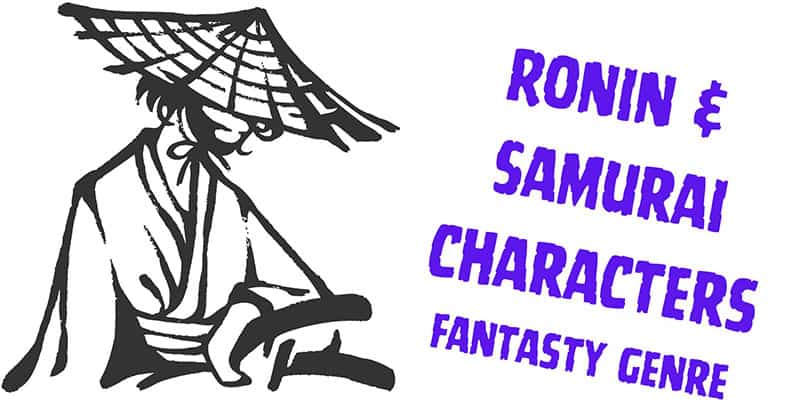Writing a samurai or ronin character in fantasy stories takes the legendary figures of real-world Japanese history and placing them against a magical world. They are defined by their skill with the blade and the discipline it takes to get that skill. The warrior is as sharp as the legendary sword they carry.
A few famous archetypes for ronin and samurai in fantasy stories include:
These characters are often tragic—whether it’s their hero’s journey or their backstory, they’ve seen and done things they would rather forget. It’s an honest and vulnerable character, but one that demands respect. They live on the edge of death and have a strange relationship with it.
That said, I want to recreate this archetype for a fantasy setting. Japan has some extraordinary mythology, full of scary monsters, forest spirits and epic heroes and gods that would be a blast to explore. Give them opponents that range from rival sword fighters to beastly monsters. Though the setting might differ from real life, we can keep the deeper character arches from the archetype you may have seen in period pieces.
Naturally, there will be some overlap in these tropes and archetypes, as writers tend to use these as elements to play with creatively. Use all of them in the same story—that would be cool.
The Blind Sword Master
This archetype is skill personified. They go beyond their disability to learn the heart of combat—a sixth sense in the rhythm, timing and distance of incoming strikes. In some iterations, this sixth sense is mostly a way of feeling attacks as they come in and instinctively knowing the counter measure to employ. In others, though, like Kenshi of Mortal Kombat, this sixth sense is cranked up to full-blown telekinesis.
This character is by nature unassuming, so other characters in the story will likely fall victim to their seeming helplessness. They would make a great teacher, offering a valuable training lesson to the protagonist in the deeper art of the flow of combat. They are also a lesson in perspective, ironically, using the lack of sight as lack of distraction and turning a weakness into a strength.
The character that launched this trope into modern storytelling is novelist Kan Shimozawa’s Zatoichi (1948). He was popularized with a series of films from the 50’s to the 2000’s. He’s the prototype of characters like Daredevil—gaining nearly preternatural combat abilities with enhanced senses and possibly a 6th one added in there. He carries the weight of his actions as a Yakuza—killing many in his younger life—so now he walks the earth trying to repent for his sins—using his senses to cheat in gambling to survive. Famously, he uses a hidden sword in his walking cane as opposed to a katana—something they paid homage to in John Wick 4 with Donnie Yen’s “Cain”.
Or, perhaps like Kenshi of Mortal Kombat, they are seeking revenge on the person who took their sight. Maybe they had to learn the hard lessons themselves about their newfound fighting senses. Maybe sight itself was a disability all along compared to this sixth sense.
The Hidden Sword Master
This archetype transcends samurai/ronin archetypes into many variations of odd ball sword or kung fu masters. Essentially, it’s the weird old man or grizzled servant that turns out to be a savant or legendary sword master. In many ways, it’s like the blind ronin—you don’t see their skill coming.
Often, this character is a teacher. Think Yoda from Star Wars. We met him as a bumbling puppet, only to learn he is the acrobatic hero in the fight against Count Duku and the Emperor in the prequel movies. This trope borrows from the wise fool you might see in Shakespeare. What you see on the surface isn’t always the complete story, and this character is a manifestation of that lesson.
Another way this character manifests is as a hidden bodyguard—someone no one realized was an incredible warrior until things get bad. (Fade/Araris in Jim Butcher’s Codex Alera). However, this archetype is still a lesson in not taking a person for granted based on their outward appearance.
The Ronin (Retribution and Honor)
This is probably the most popular—if not general—archetype in the samurai genre. Whenever a samurai loses their master or is disbanded from a conquered shogunate—warriors who once had purpose are now set to roam aimlessly on the countryside as sell swords or outlaws.
This archetype hits because of the redemption angle it naturally creates. Samurai are very proud warriors with a code of honor, a way of life and prestige to their station. When you take that away from a person, you create a situation that is hard for this kind of warrior to accept. They may be drunks or have fallen apart from their dishonor, but your story could be the reason they find redemption.
This fall from grace is an excellent launching point for a full-fledged adventure with any number of episodic chapters. We clearly have so many questions we can ask about life through a character that has experienced ultimate failure. But you as the reader know their true potential—it’s been proven from their heroic backstory in a way that highlights the unfairness of man-made societal constructs. How does a warrior who was once a hero or leader become a wandering nomad?
One of the best examples of this archetype I can think of is 47 Ronin—especially the version starring Keanu Reeves, which includes more fantasy elements than the original.
Another form this character takes is someone who has walked away from their station because of the trauma they endured during war or a fatal conflict with a prestigious samurai. Kenshin from Roroni Kenshin and Jin/Gene from Samurai Champloo are great examples of this character—as a side note, anime and manga in general perfect places for inspiration for all of these character archetypes.
The Demon Slayer
Japan knows how to do scary—oni, shape-shifting spider-women, somehow a specific style of ghost that is more terrifying than Western ghosts—so naturally a samurai style demon slayer would make a fascinating character in a world full of Yokai and magic.
This archetype is most likely to use a magic sword, with various tools of the trade for their supernatural opponents. Using sacred elements of sword construction, ki, or spells often grants these weapons the ability to harm the supernatural foes in ways that regular weapons cannot. Kind of like the Divine Sword trope in Western sword mythology that you might see in a Dungeons and Dragons game. Sometimes this magic sword isn’t even metal but a wooden bokutō with magic energies transferred through it.
If you have any interest in anime, you’ve probably seen a good example of this character—Ichigo from Bleach, Tanjiro from Demon Slayer, Kyouichi from Tokyo Majin. It’s classic good guy with a special sword meets monster—just with cooler swords and scarier monsters.
Netflix’s Love, Death and Robots has a fantastic example of this archetype (with a Chinese cultural twist) and where this character’s journey could go. When a young demon slayer learns he is hunting a nine-tailed fox that has a beautiful human form, he starts to question who the monster is. What was labeled a demon may just be the last of a mystical race of beings who just want to survive a changing world.
The Half Monster
Often, the demon slayer archetype has a unique aspect that gives them an edge in hunting monsters—being a partial monster. Blade, Vampire Hunter D, Inuyasha and Blood all include monster slayers that are half demon or half vampire.
Some are born from circumstance—like Blade—where his mother was bitten by a vampire while he was still in the womb. Others, like Saya Kisaragi of Blood are more like government experiments. In fact, she’s more full-blown monster, with her human side only hypnosis and fake memories. Bold move, guys. Either way, they carry the strengths of their enemies and less of their weaknesses.
A major storyline with this half monster is which part of themselves they lean into. They exist as a duality. One part human, another part monster. This means they have a soul, but also cravings for mayhem, blood and destruction. Naturally, this brings up a moral dilemma that will need to be explored. This character either needs to be in the process of learning that boundary, or already knows that boundary as a steadfast side character.
They can easily become ostracized by human society—painting them as monsters. I think this aspect alone connects them with the greater samurai archetype in a unique way. The violent acts of a warrior can often make them feel like monsters.
However, this could also be a terrifying villain. Can you imagine going up against a literal monster with unknown abilities in a sword fight?

